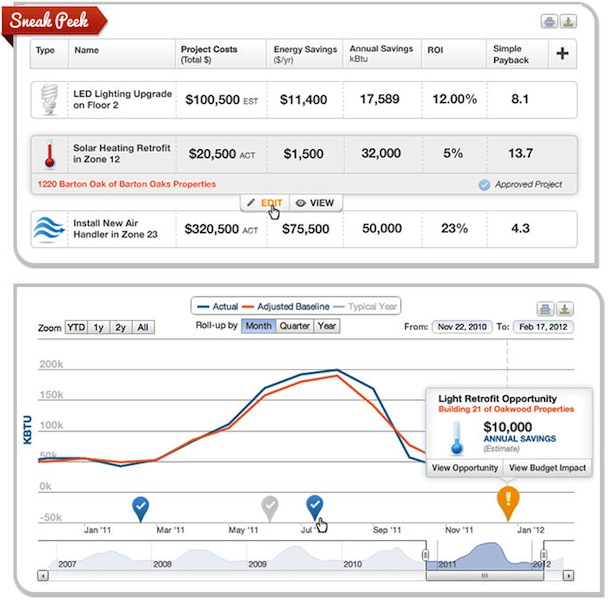How big data can help conserve energy

A Texas energy-efficiency startup has launched a Web site focused on helping businesses better manage existing power consumption, so that they can make better investments in conservation upgrades.
Noesis Energy, which raised another $8 million in venture capital in mid-September, has been testing the site in a private beta for the past five months.
As of this writing, information for more than 5,567 buildings (487 million square feet) is being aggregated by Noesis Energy to help analyze the effectiveness of various energy efficiency measures. That space represents all sorts of different facilities -- from retail shopping malls to hotels to commercial real estate and government offices.
Noesis Energy lets companies access basic information and services for free, including consumption reporting, peer benchmarking and information about the various rebates and incentives that exist to help with energy conservation. If you want to access the planning service or run return on investment (ROI) scenarios, you'll need to pay.
That version isn't available until the fourth quarter, though, so pricing information isn't published.
The screen shot below gives you a sense of what the dashboard looks like.

"There is no shortage of data in the energy industry," said Rob Day, partner with Black Coral Capital, which led Noesis Energy's recent funding round. "What is lacking are the practical insights required to make both big and small energy decisions so organizations can start realizing the tremendous amount of pent-up savings."
Austin Ventures also kicked in money for Noesis Energy's Series B financing.
More than $2 million in savings identified
Retroficiency, another software company focused on helping businesses better assess energy consumption scenarios, recently identified more than $2 million in potential energy savings for Liberty Property Trust, a real estate investment organization based in Malvern, Pa.
The analysis performed with Retroficiency's Virtual Energy Assessment technology focused on the savings potential across more than 100 buildings, scrutinizing things like lighting technologies, heating and cooling systems, building controls and other applications that could affect a company's building energy consumption.
"The detailed systems-level analysis allowed us to narrow our focus when looking at areas of potential improvement," said Dennis Skelly, senior property manager for Liberty Property. "It prompted us to do a night walk-through to further investigate some of the insights that their system found, and we've already been able to translate this into energy savings."
What's the ROI?
For perspective on how long it takes for an energy efficiency project to pay off, consider the recent example of an LED retrofit at the Miami Tower, which will take an estimated four years to recoup its ROI.
The tower's new exterior lights include 216 advanced LED fixtures that can create 16 million different colors and hundreds of different lighting effects; they replace 382 metal halide lights that offered much more static aesthetics.
The $1.5 million upgrade reduces the building's lighting energy usage by 92 percent, cut its electricity bill by about $260,000 annually and opens the door for the managers to program much more complex skyline light shows in the past, according to the companies behind the project.
Jones Lang LaSalle, Philips Color Kinetics and LED Source coordinated the retrofit on behalf of LaSalle Investment Management. Lighting updates remain one of the most widely used ways for businesses to cut power consumption relatively quickly.
"LED technology has reached a tipping point where we can achieve better light intensity than traditional lighting technologies, yet unlike traditional lighting systems, we can work with the very tight space constraints and steep angles required to light a building," said Jeff Cassis, general manager for Philips Color Kinetics. "In addition, because LED is inherently more controllable than other technologies, we have the ability to create fascinating effects with it."
(Photo used for this post's thumbnail image is courtesy of Cheryl Stieffel, New York Focus)